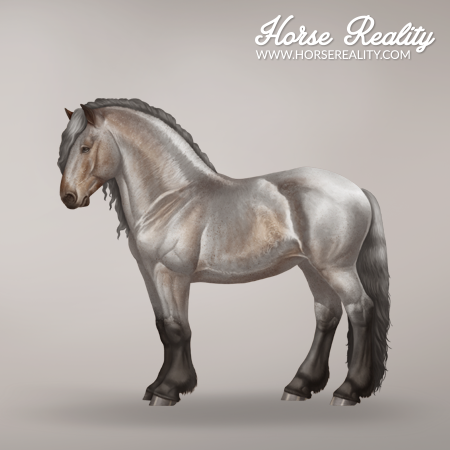Roan is one of the white patterns present in horses.
¶ Phenotype
Roan is characterised by white hairs mixed into the rest of the coat except for the head, lower legs, manes, and tail, which usually stay entirely coloured. The coloured head and the “inverted V's” on the legs are essential characteristics of the roan: Where the roan meets the coloured lower legs, an upside-down-V-shaped border can be seen. Chestnut roan horses are sometimes also named strawberry roan, and black roan horses, blue roan.
Foals are born with the coat colour determined by their genes, without white hairs. The roan pattern usually becomes visible as the foals start their first shedding. Roan horses often also show seasonal changes; the pattern is typically more apparent during spring, after shedding the winter coat. During winter, the roan pattern may become very hard to see. Sometimes the coat may even change from year to year. Unlike grey, roan doesn't progressively increase as the horse ages; if anything, horses may become darker. Roan affects any base colour, but the presence of dilutions or grey may make the white pattern harder to see.
In Horse Reality, foals will be born without any visible roan and show a roan coat once they turn into an adult (3 years old), which they keep for the rest of their life without any changes.
When the skin of the roan body gets injured, for example from a minor scratch or a bite from another horse, the new hair that grows back as it heals will usually be coloured. These dark areas on the coat of roan horses are often called corn spots or corn marks. They are especially common in wild or feral horses.
| Roan - Various breeds | |

|

|
“True” roan should not be confused with the general term of “roaning”. Other white patterns, such as (hidden) sabino, white spotting or rabicano, can also cause white hairs to get mixed into the coat. This process is often referred to as "roaning" or white ticking, but this is not caused by roan. The white ticking caused by other patterns is usually more patchy and not evenly distributed over the coat.
Another white pattern that may be mistaken for roan, is varnish roan. Although both have roan in the name, they are not related to each other. Varnish roan is a leopard complex pattern, also characterised by mixed-in white hairs. However, varnish roans will usually gradually “varnish out” as they age and their white pattern is more unevenly distributed. The bony areas (legs, cheekbones. etc) retain their pigment longer. They also have the typical leopard complex characteristics: mottled skin, striped hooves, and white sclera (the area around the pupils).
| Varnish roan - Noriker Horse |

|
¶ Genotype
The dominant RN-allele causes Roan. Homozygous (RN/RN) and heterozygous roans (RN/n) are identical in appearance. The exact mutation responsible for roan hasn't been discovered yet in real life, but it has been assigned to the KIT locus. The DNA tests that have been developed for roan, test for other genetic markers which can indicate the presence of roan, rather than roan itself. This test is therefore not always 100% reliable for all breeds in real life. In Horse Reality, roan can be tested accurately at the Laboratory.
There also appear to have occurred novel roan mutations in certain breeds, such as the Thoroughbred (Catch A Bird). While these horses show all the typical roan characteristics, it is unclear whether this is the same mutation as in other breeds. In Horse Reality, though, they are all treated as RN-alleles on the KIT locus.
Below, the resulting phenotype of each genotype is listed:
- RN/RN = Roan
- RN/n = Roan
- n/n = Not roan
Roan can of course also be present together with other KIT alleles - however, since they are located on the same gene, horses can only be heterozygous:
- TO/RN = Tobiano roan
- SB1/RN = Sabino1 roan
- RN/Wx = Roan White spotting x
¶ Breeds
Roan is fairly common in the draft-, pony- and North American breeds; but can also be found in some warmbloods. The following table lists all breeds that can currently have the roan (RN) allele in-game:
| Breeds |
| Akhal-Teke Horse |
| Arabian Horse |
| Brabant Horse |
| Brumby Horse |
| Camargue Horse |
| Cleveland Bay |
| Exmoor Horse |
| Finnhorse |
| Fjord Horse |
| Friesian Horse |
| Haflinger Horse |
| Icelandic Horse |
| Irish Cob Horse |
| Kladruber Horse |
| Knabstrupper |
| Lipizzaner |
| Lusitano |
| Mongolian Horse |
| Mustang Horse |
| Namib Desert Horse |
| Noriker Horse |
| Norman Cob |
| Oldenburg Horse |
| Pantaneiro Horse |
| Pura Raza Española |
| Quarter Horse |
| Shetland Pony |
| Shire Horse |
| Suffolk Punch |
| Thoroughbred |
| Trakehner Horse |
| Welsh Pony |
¶ References
- Bellone R., Sponenberg D. P., Equine Color Genetics, 4th Edition, 2017, Wiley-Blackwell
- Bowling A, Ruvinsky A., 2000, The Genetics of the Horse, 2000
- UC Davis Veterinary Genetics Laboratory; https://vgl.ucdavis.edu/test/roan; Access: November 2022